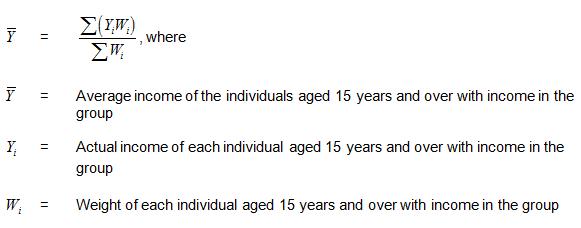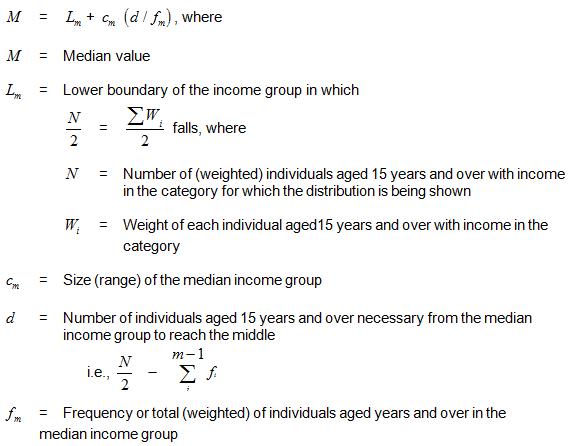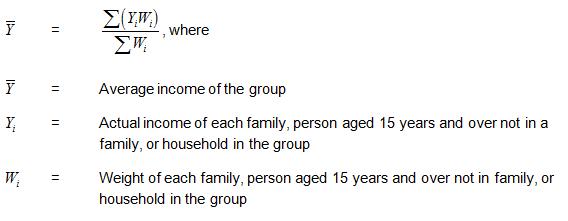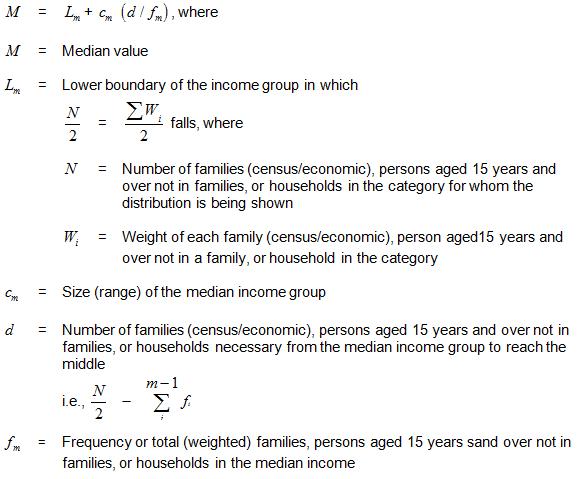Archived Content
Information identified as archived is provided for reference, research or recordkeeping purposes. It is not subject to the Government of Canada Web Standards and has not been altered or updated since it was archived. Please contact us to request a format other than those available.
Appendix 3.1 Derived Statistics
There are three statistics not resident on the database that can readily be computed on income variables: (1) average and (2) median.
These statistics can be derived for total income, after-tax income, earnings, wages and salaries, or any other particular source of income on a variety of universes. The statistic calculation is explained for two groups of universes: individuals and all other universes which include families, persons not in families and households.
A. Income of individuals
Average and median incomes will be calculated for those individuals who are at least 15 years of age and who have an income or after-tax income (positive or negative). For all other universes (for example, census families or private households), these statistics will be calculated over all units, whether or not they reported any income.
1. Average income of individuals
Average income of individuals refers to the dollar amount obtained by adding up the total income of all individuals aged 15 years and over who reported income for 2010 and dividing this sum by the number of individuals with income.
Average income is calculated from unrounded data by dividing the weighted aggregate income of a specified group of individuals (for example, males aged 45 to 54 years) by the number of individuals with income in that group.
Average income is calculated for any group as follows:
Description - Average income of individuals
Average income of individuals, Y bar, equals to summation of (Y subscript i times W subscript i) divided by (summation of W subscript i), where:- Y bar is equal to the average income of the individuals aged 15 years and over with income in the group
- Y subscript i is equal to the actual income of each individual aged 15 years and over with income in the group
- W subscript i is equal to the weight of each individual aged 15 years and over with income in the group

2. Median income of individuals
The median income of a specified group of income recipients is that dollar amount which divides their income size distribution ranked by size of income, into two halves, i.e., the incomes of the first half of individuals are below the median, while those of the second half are above the median. Median income is calculated from the unrounded number of individuals (for example, males aged 45 to 54 years) with income in that group.
For an income size distribution, the median is usually estimated as follows:
Description - Median income of individuals
Median income of individuals, M, equals to L subscript lowercase m plus c subscript lowercase m times (d divided by f subscript lowercase m), where:- M is equal to median value
- L subscript lowercase m is equal to the lower boundary of the income group in which N divided by 2 is equal to (summation of W subscript i) divided by 2, where:
- N is equal to the number of (weighted) individuals aged 15 years and over with income in the category for which the distribution is being shown
- W subscript i is equal to the weight of each individual aged 15 years and over with income in the category
- c subscript lowercase m is equal to the size (range) of the median income group
- d is equal to the number of individuals aged 15 years and over necessary from the median income group to reach the middle, that is, (N divided by 2) minus (summation over i from 1 to (lowercase m minus 1) of f subscript i)
- f subscript lowercase m is equal to the frequency or total (weighted) of individuals aged 15 years and over in the median income group

In a similar fashion, decile income values (nine dollar amounts which divide the income recipients in 10 equal groups), quintiles (five equal groups) and quartiles (four equal groups) can also be derived for the population with income.
B. Income of families, persons not in families, and households
Average and median income of families (both census and economic families), persons aged 15 years and over not in families and households are normally calculated for all units in the specified group, whether or not they reported income.
For the universe of individuals, these statistics are normally calculated for those individuals who are at least 15 years of age and have reported an income (positive or negative).
1. Average income of families (census/economic), persons not in families, and households
Dollar amount obtained by adding up the total income of all family members (census/economic), persons aged 15 years and over not in families, or households and dividing this sum by the number of families, persons aged 15 years and over not in families, or households.
Average income of families (census/economic) or persons aged 15 years and over not in families or households refers to the weighted mean total income of families (census/economic), persons aged 15 years and over not in families, or households in 2010.
Average income is calculated from unrounded data by dividing the aggregate income of a specified group of families (for example, husband-wife families with working wives), persons aged 15 years and over not in families, or households (for example, family households) by the number of families, persons aged 15 years and over not in families, or households in that group, whether or not they reported income
This statistic is calculated for any group as follows:
Description - Average income of families (census/economic), persons not in families, and households
Average income of families, persons not in families or households, Y bar, equals to summation of (Y subscript i times W subscript i) divided by (summation of W subscript i), where:- Y bar is equal to the average income of the individuals aged 15 years and over with income in the group
- Y subscript i is equal to the actual income of each individual aged 15 years and over with income in the group
- W subscript i is equal to the weight of each individual aged 15 years and over with income in the group

2. Median income of families (census/economic), persons not in families, and households
The median income of a specified group of families (census/economic), persons aged 15 years and over not in families, or households is that amount which divides their income size distribution ranked by size of income, into two halves. That is, the incomes of the first half of the families, persons aged 15 years and over not in families, or households are below the median, while those of the second half are above the median. Median incomes of families (census/economic), persons aged 15 years and over not in families, or households are normally calculated for all units in the specified group, whether or not they reported income.
For an income size distribution, the median is estimated as follows:
Description - Median income of families
Median income of families, persons not in families or households, M, equals to L subscript lowercase m plus c subscript lowercase m times (d divided by f subscript lowercase m), where:- M is equal to median value
- L subscript lowercase m is equal to the lower boundary of the income group in which N divided by 2 is equal to (summation of W subscript i) divided by 2, where:
- N is equal to the number of (weighted) individuals aged 15 years and over with income in the category for which the distribution is being shown
- W subscript i is equal to the weight of each individual aged 15 years and over with income in the category
- c subscript lowercase m is equal to the size (range) of the median income group
- d is equal to the number of individuals aged 15 years and over necessary from the median income group to reach the middle, that is, (N divided by 2) minus (summation over i from 1 to (lowercase m minus 1) of f subscript i)
- f subscript lowercase m is equal to the frequency or total (weighted) of individuals aged 15 years and over in the median income group

In a similar fashion, decile income values (nine dollar amounts which divide the units in 10 equal groups), quintiles (five equal groups) and quartiles (four equal groups) can also be derived for the groups of interest.
- Date modified: